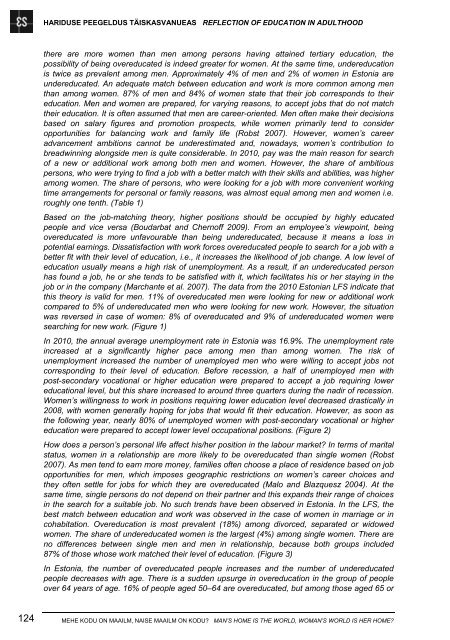MEHE KODU ON MAAILM, NAISE MAAILM ON KODU? - Tartu Ãlikool
MEHE KODU ON MAAILM, NAISE MAAILM ON KODU? - Tartu Ãlikool
MEHE KODU ON MAAILM, NAISE MAAILM ON KODU? - Tartu Ãlikool
Create successful ePaper yourself
Turn your PDF publications into a flip-book with our unique Google optimized e-Paper software.
HARIDUSE PEEGELDUS TÄISKASVANUEAS REFLECTI<strong>ON</strong> OF EDUCATI<strong>ON</strong> IN ADULTHOOD<br />
there are more women than men among persons having attained tertiary education, the<br />
possibility of being overeducated is indeed greater for women. At the same time, undereducation<br />
is twice as prevalent among men. Approximately 4% of men and 2% of women in Estonia are<br />
undereducated. An adequate match between education and work is more common among men<br />
than among women. 87% of men and 84% of women state that their job corresponds to their<br />
education. Men and women are prepared, for varying reasons, to accept jobs that do not match<br />
their education. It is often assumed that men are career-oriented. Men often make their decisions<br />
based on salary figures and promotion prospects, while women primarily tend to consider<br />
opportunities for balancing work and family life (Robst 2007). However, women’s career<br />
advancement ambitions cannot be underestimated and, nowadays, women’s contribution to<br />
breadwinning alongside men is quite considerable. In 2010, pay was the main reason for search<br />
of a new or additional work among both men and women. However, the share of ambitious<br />
persons, who were trying to find a job with a better match with their skills and abilities, was higher<br />
among women. The share of persons, who were looking for a job with more convenient working<br />
time arrangements for personal or family reasons, was almost equal among men and women i.e.<br />
roughly one tenth. (Table 1)<br />
Based on the job-matching theory, higher positions should be occupied by highly educated<br />
people and vice versa (Boudarbat and Chernoff 2009). From an employee’s viewpoint, being<br />
overeducated is more unfavourable than being undereducated, because it means a loss in<br />
potential earnings. Dissatisfaction with work forces overeducated people to search for a job with a<br />
better fit with their level of education, i.e., it increases the likelihood of job change. A low level of<br />
education usually means a high risk of unemployment. As a result, if an undereducated person<br />
has found a job, he or she tends to be satisfied with it, which facilitates his or her staying in the<br />
job or in the company (Marchante et al. 2007). The data from the 2010 Estonian LFS indicate that<br />
this theory is valid for men. 11% of overeducated men were looking for new or additional work<br />
compared to 5% of undereducated men who were looking for new work. However, the situation<br />
was reversed in case of women: 8% of overeducated and 9% of undereducated women were<br />
searching for new work. (Figure 1)<br />
In 2010, the annual average unemployment rate in Estonia was 16.9%. The unemployment rate<br />
increased at a significantly higher pace among men than among women. The risk of<br />
unemployment increased the number of unemployed men who were willing to accept jobs not<br />
corresponding to their level of education. Before recession, a half of unemployed men with<br />
post-secondary vocational or higher education were prepared to accept a job requiring lower<br />
educational level, but this share increased to around three quarters during the nadir of recession.<br />
Women’s willingness to work in positions requiring lower education level decreased drastically in<br />
2008, with women generally hoping for jobs that would fit their education. However, as soon as<br />
the following year, nearly 80% of unemployed women with post-secondary vocational or higher<br />
education were prepared to accept lower level occupational positions. (Figure 2)<br />
How does a person’s personal life affect his/her position in the labour market? In terms of marital<br />
status, women in a relationship are more likely to be overeducated than single women (Robst<br />
2007). As men tend to earn more money, families often choose a place of residence based on job<br />
opportunities for men, which imposes geographic restrictions on women’s career choices and<br />
they often settle for jobs for which they are overeducated (Malo and Blazquesz 2004). At the<br />
same time, single persons do not depend on their partner and this expands their range of choices<br />
in the search for a suitable job. No such trends have been observed in Estonia. In the LFS, the<br />
best match between education and work was observed in the case of women in marriage or in<br />
cohabitation. Overeducation is most prevalent (18%) among divorced, separated or widowed<br />
women. The share of undereducated women is the largest (4%) among single women. There are<br />
no differences between single men and men in relationship, because both groups included<br />
87% of those whose work matched their level of education. (Figure 3)<br />
In Estonia, the number of overeducated people increases and the number of undereducated<br />
people decreases with age. There is a sudden upsurge in overeducation in the group of people<br />
over 64 years of age. 16% of people aged 50–64 are overeducated, but among those aged 65 or<br />
124<br />
<strong>MEHE</strong> <strong>KODU</strong> <strong>ON</strong> <strong>MAAILM</strong>, <strong>NAISE</strong> <strong>MAAILM</strong> <strong>ON</strong> <strong>KODU</strong>? MAN’S HOME IS THE WORLD, WOMAN’S WORLD IS HER HOME?

















